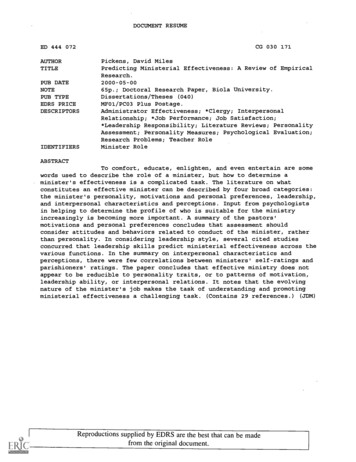
Transcription
DOCUMENT RESUMEED 471 474AUTHORTITLEINSTITUTIONJC 030 026Wilson, Cynthia, Ed.; Milliron, Mark David, Ed.Leadership Abstracts, 2002.League for Innovation in the Community Coll., Laguna Hills,CA.PUB DATENOTEAVAILABLE FROMPUB TYPEJOURNAL CITEDRS PRICEDESCRIPTORS2002-00-0044p.; For Volume 14, see ED 467 977.For full text: http://www.league.org/leadabst.html.Collected WorksSerials (022)Leadership Abstracts; v15 n1-12 Jan-Dec 2002EDRS Price MF01/PCO2 Plus Postage.*Distance Education; Access to Education; Budgets;Certification; *Community Colleges; *Educational Finance; JobSkills; *Job Training; Labor Force Development; Leadership;*Online Courses; Two Year Colleges; Vocational EducationABSTRACTThis 2002 volume of Leadership Abstracts contains issuenumbers 1-12. Articles include: (1) "Skills Certification and WorkforceDevelopment: Partnering with Industry and Ourselves," by Jeffrey A. Cantor;(2) "Starting Again: The Brookhaven Success College," by Alice W. Villadsen;(3) "From Digital Divide to Digital Democracy," by Gerardo E. de los Santos,Alfredo de los Santos, Jr., and Mark David Milliron; (4) "Lifelong Learning:A Funding Priority," by Larry J. Warford; (5) "Funding: A Shared Cause forToday's 'Miracle Workers,'" by Senator Edward M. Kennedy; (6) "'GlobalVillage Idiocy' and the Community College," by Thomas L. Friedman; (7)"Creating New Energy for Change," by Nancy Stetson; (8) "Turning KnowledgeInto Action: What's Data Got to Do With It?" by Lisa A. Petrides; (9)"Leading the Way to Connect Community to the College," by Charles J. Carlsen;(10) "Leadership by Culture Management," by Christine McPhail; (11) "A Viewfrom the Outside In: Community Colleges as Entrepreneurial Community LearningCenters," by Zane Tarence; and (12) "Students' Perspectives on Juggling Work,Family, and College," by Lisa Matus-Grossman and Susan Gooden. (NB)Reproductions supplied by EDRS are the best that can be madefrom the original document.
Leadership Abstracts, 2002EditorsCynthia WilsonMark David MillironLeadership Abstractsv15 n1-12 Jan-Dec 2002League for Innovation in the Community CollegeU.S. DEPARTMENT OF EDUCATIONOffice of Educational Research and ImprovementEDUCATIONAL RESOURCES INFORMATIONCENTER (ERIC)0 This document has been reproduced asreceived from the person or organizationoriginating it.UoPERMISSION TO REPRODUCE ANDDISSEMINATE THIS MATERIAL HASBEEN GRANTED BYT. O'Ban ionMinor changes have been made to improvereproduction qualityPoints of view or opinions stated in thisdocument do not necessarily representofficial OERI position or policy.TO THE EDUCATIONAL RESOURCESINFORMATION CENTER (ERIC)1BEST COPY AVAILABLE
League for Innovation in the Community CollegeLeadership AbstractsJanuary 2002 Volume 15, Number 1Skills Certifications and Workforce Development:Partnering with Industry and OurselvesJeffrey A. CantorRapidly changing workplace technology requirements have increased the burden on workersand employers to maintain workplace skills and to document worker competencies.Community colleges have long been recognized for providing vital workforce training tomeet the needs of local business and industry, for cost-effective services, and forgeographic accessibility. Now community colleges are playing a distinct role by offeringcredentials in particular occupations, combined with the broader education that is part of awell-rounded degree program. The challenges now posed to the community college to fulfillthis mission have become manifest: to document individual student competencies, identifymeaningful benchmarks of student success, and maintain program relevance.One way to meet these challenges is through the use of a new dimension in workforceeducation, industry worker certification, which serves as a resource and benchmark forstate-of-the-art curriculum and program development, a tool for marketing programeffectiveness and portability to students as well as employers, and a competency-basedbridge between noncredit continuing education and degree programs.All too often, however, certification is separated, even segregated, by curriculum planners.For certification to reach its full potential for work and training, we must end this separationand partner not only with industry, but with ourselves.Certification and Its PopularitySome confusion persists about what certification means. In simplest terms, certification is aconfirmation of one's adequate knowledge and skills in a specified occupation oroccupational specialty. Certification can be classified into two areas: (1) certifications issuedby industry that are product-related (e.g., Cisco-CCNA) and (2) certifications issued byorganizations or professional associations (e.g., Certified Professional Accountant).Certifications are generally issued for a defined period of time, after which the individualmust satisfy continuing education requirements and pass another series of examinations todemonstrate continued competency. The sponsoring organization oversees the proceduresfor obtaining the certification and also the standards that are applied to the occupationalclassifications that are certified.Increasing numbers of employers are turning to certifications as a means of ensuring thatprospective employees actually do have the requisite skills for an occupational specialty.Employers are asking educational institutions to incorporate certification exam opportunitiesinto their programs as a further way for students to demonstrate the necessary workplaceskills, along with their diplomas. Students find that certifications can be earned in a muchshorter period of time than full associate degree programs take, and that certifications oftenlead to higher starting salaries.Today, 15-20 percent of community college students already hold bachelor's degrees.Students enrolling in our colleges for specific courses and programs are not staying for thefull associate degree. At one college with a well-developed Information Technology degreeprogram, for example, only 13 percent of the IT students obtained an associate degree overABEST COPY AVAILABLE
a period of three years. Instead, our colleges have become major retrainers of theworkforce. At the same time, while 70 percent of our nation's high school graduates entercollege, only about 33 percent complete a degree and one-third of those take jobs that donot require that degree. The data indicate that many community college students attendcollege to gain relevant occupational skills, not degrees. While the value of a college degreeis still recognized, a need for worker continuing education has increased exponentially.Many workers find that their needs are not fully met by the traditional core curriculum.Skill certifications can be complementary to college programs and can be an effective bridgeto industry. They offer state-of-the-art educational programs that afford studentsrecognized credentials attesting to the student's competencies and readiness for work. Manycolleges are blending certificate programs into degree programs as an option. Some awardcredit for specific courses that have skill competencies overlapping with those demonstratedvia the certification. Learning has indeed become less linear as workers are seeking blocksof skills at different times during their careers. They also want documented evidence of theirskills for job mobility. As a result, credentialing programs that convey job-related skills arebeginning to make lifelong learning's greatest impact.Certifications as Benchmarks and ResourcesCertification requirements are built upon contemporary industry worker skill requirements;therefore, they serve as reasonable foundations for educational program design. Collegeprograms designed to incorporate industry-developed certification requirements establishcredibility with local industry and ensure industry buy-in. These programs form a foundationfor partnerships with industry. Microsoft's Microsoft Certified Systems Engineer (MCSE) andCisco Systems Corporation's Cisco Certified Networking Associate (CCNA) training andcertification preparation programs are two examples of certifications that have beenintegrated into community college programs. Cisco, for example, provides CCNA guidelinesto Norwalk Community College (CT), which then provides a four-course sequence of studyas part of an Associate in Applied Science degree. This sequence prepares students tochallenge the CCNA exam, administered by a local Sylvan Prometrics Center on behalf ofCisco. Students can complete the four courses, pass the exam, move into the IT industry,and, if they choose, complete the AAS degree. The data on student success in passing theexam is used to determine if the college has satisfied student needs through the CCNAprogram.Similarly, Microsoft provides guidelines for offering a curriculum incorporating therequirements of MCSE, MCP, MOUS and other certifications. Several Connecticut communitycolleges have partnership arrangements with proprietary computer training providers tooffer students and local firms access to Microsoft certification training.Vendor-neutral certification programs such as CompTIA's A Computer Repair Technicianprogram offered at Norwalk Community College are also growing in number and popularity.The A Computer Repair certification preparation program has been at capacity enrollmentfor several years. The A Certification and NETWORK Certification are based on aCompTIA standard for those working in the personal computer industry as technicians, helpdesk staff, and support staff.At Norwalk Community College, we have witnessed a groundswell of interest in programs incomputer and information technology. NCC has an internal articulation agreement for theCisco CCNA as well as the Microsoft MOUS program. These programs have been fullyenrolled since their inception. Students who pass the CCNA exam are afforded credit by theNCC faculty toward the Associate in Applied Science degree in Computer InformationSystems under our credit by examination policies. They can receive credit for four
networking courses. Likewise, they can get credit for passing Microsoft certification exams.This affiliation affords the college an opportunity to expand its noncredit offerings tocomputer networking technology as well.Norwalk has similar arrangements in the areas of medical transcription and billing. OtherConnecticut community colleges have certification to credit arrangements in Certified NurseAssistant and Child Development Associate areas.In the health careers field, many community colleges have long provided Certified NurseAide (CNA), Phlebotomy Technician Specialist, and EKG Technician licensure-trainingprograms. Norwalk Community Colleges provides a short program leading to a certificationthat qualifies the student candidate for Connecticut licensure. Medical coding and billing,and medical transcription, are also popular certification areas. These courses andcertifications subscribe to the Academy of Professional Coders standards.The business and finance milieu also relies on worker skills certifications as benchmarks ofcompetency. Community colleges have entered this arena by offering such certificationtraining as Certified Financial Planner (CFP). The CFP designation is a recognized standardfor financial services professionals in insurance, banking, trust management, andaccounting. The CFP certification is generally a post-baccalaureate credential, meaning thatcommunity colleges provide a continuing professional education service. NorwalkCommunity College is partnering with Kaplan Colleges to offer an online certificate inFinancial Planning.Program OutcomesWhy have industry-developed worker competency certification programs proliferated?Business leaders say that a well-rounded education is very important, but today's firmsneed a workforce with up-to-date technical skills in order to maintain a competitive edge inthe marketplace.Industry certification programs provide colleges with an opportunity to evaluate theirprogram successes and make the outcomes known to students and employers. Throughtesting venues such as Sylvan Prometrics, colleges can arrange for data on test-takeroutcomes to use in evaluating the college programs and thus better advertise them.The challenge for community college leaders is to provide a lifelong learning opportunityparalleling a worker's career path wherein students can initially gain the skills needed forjob entry and later be able to continue through the college degree.Put simply, by partnering with industry, these certifications lead to jobs; by partnering withourselves and building certification into ongoing curricular programs, these certificationslead to lifelong learning.Jeffrey A. Cantor (jcantorgncc.commnetedu) is Dean, Extended Studies & WorkforceEducation, at Norwalk Community College (CT).Volume 15, Number 1January 2002Cynthia Wilson, Editor in ChiefBoo Browning, Managing EditorCynthia Wilson, Editor in ChiefBoo Browning, Managing Editor
League for Innovation in the Community CollegeLeadership AbstractsFebruary 2002 Volume 15, Number 2STARTING AGAIN: THE BROOKHAVEN SUCCESS COLLEGEAlice W. VilladsenWhether we realize it or not, organizations have opportunities to start again. It might be thearrival of a new president, vice-president, dean, or division chair that provides the occasion.The installation of a new information technology system might take many college processesand even policies back to square one, requiring change. Perhaps a college reaches therealization that its planning systems are outmoded, with accreditation on the horizon. Itmight even be a time marker-a new decade or an anniversary of the college founding-thatgives rise to a new-day style of thinking.As the incoming president of Brookhaven College (BHC) in July of 1998, I knew that myarrival might present an opportunity for starting again at the college. Several circumstancescoincided to make me realize the possibility: The college was ready to celeb
to Norwalk Community College (CT), which then provides a four-course sequence of study as part of an Associate in Applied Science degree. This sequence prepares students to challenge the CCNA exam, administered by a local Sylvan Prometrics Center on behalf of. Cisco. Students can complete the four courses, pass the exam, move into the IT industry,











